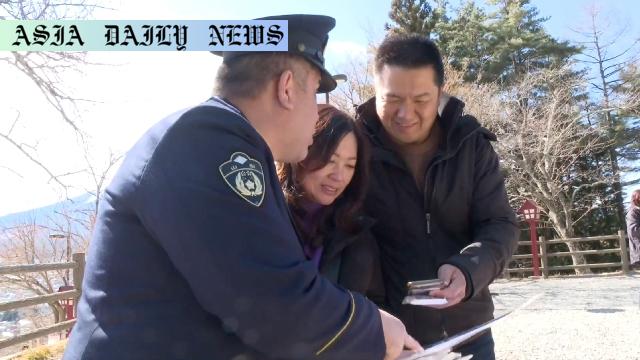Foreign Drivers – Japanese police focus effort on ensuring safe driving by foreign rental car drivers near Mount Fuji amid growing traffic accidents.
Japanese police see a rise in accidents near Mt. Fuji involving foreign drivers.
Last year, 769 accidents involved rental cars driven by foreigners in the Fuji-hokuroku area.
Police distribute multilingual flyers and launch a park campaign to raise safety awareness among tourists.
Locals are urged to understand that foreign visitors may be unfamiliar with Japanese driving rules.

Introduction: The Growing Issue
The beautiful and iconic Mount Fuji has long been a magnet for international tourists visiting Japan. However, a concerning trend has emerged in recent years—an increasing number of traffic accidents involving foreign drivers, particularly tourists renting cars to explore the area. Last year alone, 769 such accidents were reported in the Fuji-hokuroku region, marking the highest figure in the past decade. Authorities in Yamanashi Prefecture are now stepping up efforts to address this issue by launching campaigns aimed at promoting safe driving practices among foreign visitors.
The Statistics Speak Loudly
The Fuji-hokuroku region, an area north of Mt. Fuji known for its scenic beauty, has seen a worrying rise in traffic accidents. Out of the total 769 incidents recorded last year, a significant number involved rental cars driven by foreigners. These figures highlight the urgent need for measures focused on ensuring the safety of both tourists and local residents.
A Proactive Approach by Japanese Authorities
Yamanashi Prefecture’s police have taken a proactive approach by launching awareness campaigns targeting foreign drivers. One such initiative unfolded recently in the town of Fujikawaguchiko, home to numerous rental car agencies catering to tourists. Officers distributed flyers written in multiple languages explaining Japan’s traffic rules. These flyers included QR codes, allowing drivers to access maps pinpointing locations with frequent accidents.
On-Ground Campaigns for Greater Impact
In addition to the rental car agencies, police also extended their efforts to popular tourist locations, such as a park in Fujiyoshida City that offers breathtaking views of Mt. Fuji and an iconic five-story pagoda. Tourists often gather here for photos, increasing the interaction between local authorities and foreign visitors. Officers like Wada Kohei from the city’s traffic division emphasized the importance of following local traffic laws and driving responsibly.
Challenges for Local Residents
While the safety campaign primarily targets foreign drivers, it also serves as a reminder for local residents. Authorities are asking locals to exercise patience and consider the unfamiliarity many tourists have with Japanese traffic norms. Mutual understanding can play a key role in ensuring a safer driving environment for everyone in the area.
Using Technology to Enhance Safety
The adoption of technology has proven to be a valuable asset in this campaign. QR codes on flyers enable tourists to access accident hotspots and plan their routes accordingly. Additionally, informational websites and apps focused on Japanese traffic laws are being promoted to help foreign visitors understand the rules before they hit the road.
Conclusion: A Call for Collective Responsibility
Efforts to address the rising number of traffic accidents near Mount Fuji are a testament to the proactive measures being undertaken by Japanese authorities. However, the success of these initiatives depends on collective responsibility from tourists and locals alike. As more international visitors flock to this iconic destination, it is essential to foster a culture of safety and understanding to protect the lives of both residents and travelers.



Commentary
Understanding the Root of the Problem
It’s no surprise that Mount Fuji attracts millions of visitors annually. Its unparalleled scenic beauty and cultural significance make it a dream destination. However, with increasing numbers of tourists renting cars to traverse the area, the challenges of navigating Japanese roadways are also magnified. Many of these drivers come from countries with vastly different traffic systems, leading to a higher potential for accidents. Addressing this issue requires not just stricter enforcement but also preventive measures, such as creating awareness around Japan’s unique traffic laws.
The Role of Technology in Solutions
I find it particularly commendable that Yamanashi police are leveraging technology to engage with foreign drivers. By using QR codes on multilingual flyers, authorities are ensuring that tourists have access to critical information in a format that is both familiar and practical. This innovative approach could act as a model for other tourist-heavy regions facing similar challenges.
Collaboration Between Locals and Tourists
Another crucial aspect of this issue is fostering mutual respect and understanding between locals and visitors. While it’s important for foreign drivers to educate themselves about Japanese traffic rules, locals should also recognize the challenges tourists face. A collaborative effort can help create an environment of patience and cooperation, ultimately enhancing safety for everyone.
Final Thoughts
In conclusion, the rise in accidents involving foreign drivers near Mount Fuji is an issue that warrants attention. However, I am optimistic that the steps being taken by Japanese authorities will lead to positive outcomes. With consistent effort and collaboration, we can strike a balance that allows tourists to enjoy the region’s beauty while ensuring the safety of all who travel these roads.